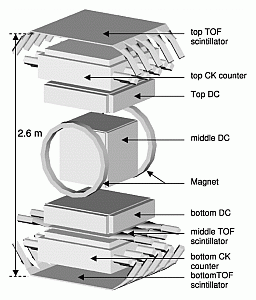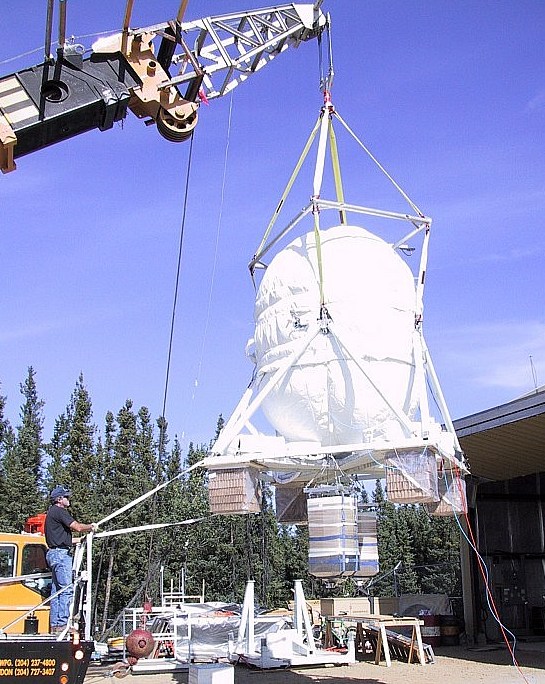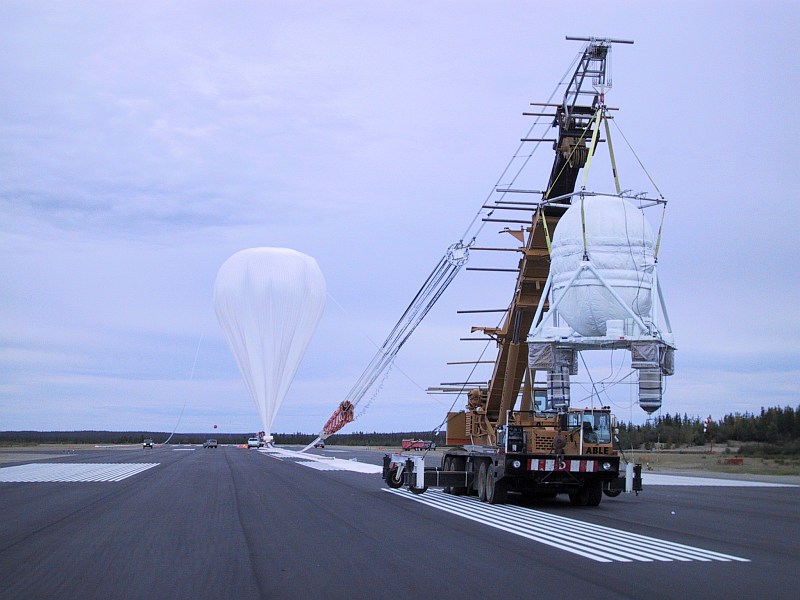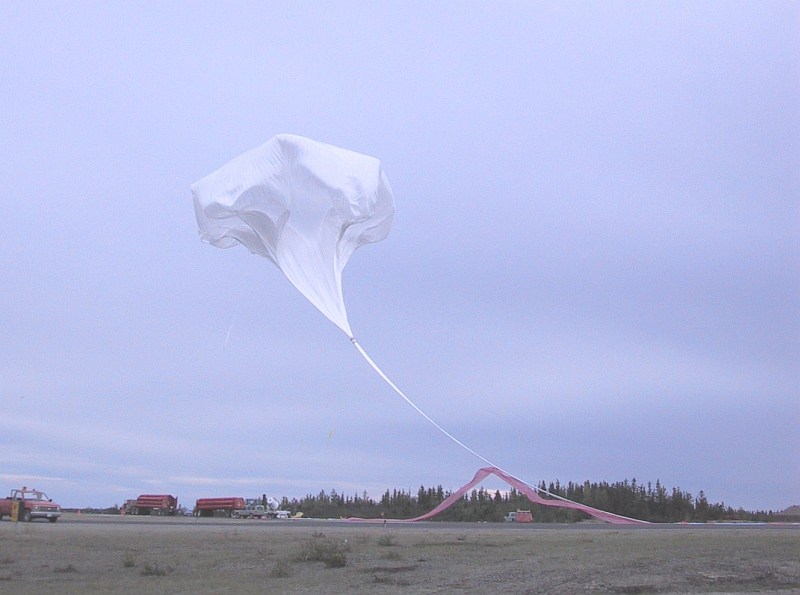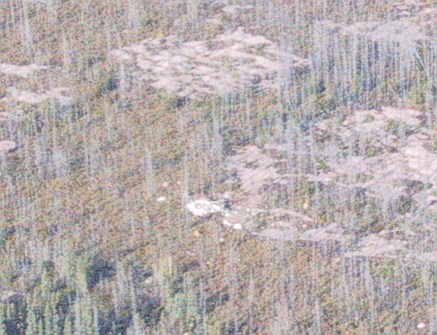Purpose of the flight and payload description
The Isotope Magnet Experiment (ISOMAX) is a balloon-borne instrument developed to measure the isotopic composition of the light elements in the cosmic radiation, in order to understand it's origin, propagation and lifetime.
The core of the instrument was a Helmholtz coil pair superconducting magnetic spectrometer and a 3 module drift chamber tracking system. The coils had an outer diameter of 79 cm and were separated by 80 cm face-to-face.
The tracking system is based on a drift chamber design developed originally for the IMAX instrument. The 3 modules were separated by 2 spacers giving a total height of the tracking system of 150 cm. The drift chambers used a total of 480 hexagonal drift cells with a radius of 1.56 cm. These cells were arranged in double or quad layers with 16 layers in the bending direction and 8 layers in the non-bending view. The outer chambers were 69 cm wide while the middle chamber had a width of 47 cm. The chambers were operated with pur CO2 which has a slow drift velocity.
The drift chambers were read out by custom-designed low power preamplifier/discriminator modules. The ISOMAX time-of-flight (ToF) was composed of 3 layers of plastic scintillators and provided the trigger of the instrument, determining the charge of the incident particles by dE/dx-measurements and measuring the velocity of the particles up to energies of about 1.2 GeV/nucleon. The top and bottom layers consisted of 5 paddles, each measuriong 20 cm x 100 cm and 1 cm thick. The middle layer consisted of 3 paddles (23 cm x 69 cm and same thick). Both ends of each paddle were connected to adiabatic, acrylic light-pipes which were attached to linear focussed photomultiplier tubes (PMTs). The PMT signals were then split: while one output was digitized by an Analog to Digital Converter (ADC) for the dE/dx-measurement with a high and a low gain, the other output was fed into leading edge discriminators, which used 2 threshold levels, providing both, the first level event trigger and the velocity measurement of the ToF.
The Cherenkov detector consisted of 2 large diffusive-light-integration counters (88 x 88 x 14 cm). each containing two layers of silica-aerogel radiators (each 2 cm thick). The light was collected by 16 PMTs per counter. In order to cover the dynamic range of the light isotope measurement the PMTs signals were fed into charge sensitive preamplifiers with a low and high gain output, which were then digitized by ADC modules.
The data handling and control was performed by a PC/104-format computer with an Intel x86 CPU. The instrument was fully commandable from the ground by a custom telemetry/frame-sync board.
The whole instrument was contained inside a pressurized vessel, which was comprised of an aluminium midsection, which carried all the mechanical loads, and 2 flexible Kevlar domes. This was mounted over a platform which served sustained the bars that carried the mechanical load from the central ring. Also provided attaching points to mount the ballast container, flight electronics, crush pads, batteries, and all other elements that no needed to be enclosed in the pressure vessel.
The instrument had a total weight of 2200 kg.
Details of the balloon flight
Balloon launched on: 9/1/2000 at 00:03 utc
Launch site: Lynn Lake Airport, Manitoba, Canada
Balloon launched by: National Scientific Balloon Facility (NSBF)
Balloon manufacturer/size/composition: Zero Pressure Balloon 1.100.000 m3 - SF3-39.57-.8/.8/.8/.8-NHR
Balloon serial number: W39.57-3-22
Flight identification number: 488N
End of flight (L for landing time, W for last contact, otherwise termination time): 9/1/2000 at 1:45 utc
Landing site: Payload crashed near South Indian Lake, Alberta, Canada
The balloon was launched using the dynamic method with the help of a crane acting as launch vehicle on September 1st 2000.
While ascending, when the balloon broke the landmark of 10 km of altitude, the top part of the Kevlar pressure vessel of the instrument ruptured and the sudden pressure drop inside the gondola caused severe damage to the detector systems marking the end of the scientific part of the mission.
After a while when was decided to terminate the balloon, an accident occured causing the total destruction of the payload whose remains were recovered near South Indian Lake, Alberta, Canada.
As this second flight of the instrument was expected to have a longer duration a low-power data
acquisition and trigger electronics was incorporated to reduce the power consumption allowing to use similar battery packs as for the 1998 flight. Elimination of the heavy CAMAC electronic and other structural modifications also reduced payload weight thus increasing ballast margins.
On regard the instrument itself, silica-aerogel radiators with an optical index of 1.043 were used to allow measurements of isotopes to energies of 3 GeV/nucleon.
Sadly early in the climbing phase of the balloon flight the pressurized gondola failed and the sudden pressure loss damaged severely the detectors, forcing to abort the mission. Later a failure during termination led to the total destruction of the payload in the ground impact.
External references
- ISOMAX website at Goddard Space Flight Center
- ISOMAX website at University of Siegen
- A Telemetry/Frame Sync Board for Use in Balloon Payloads 24th International Cosmic Ray Conference, Vol. 3 Pag. 623
- ISOMAX: A Balloon-bome Instrument to Study Beryllium and Other Light Isotopes in the Cosmic Radiation 23rd International Cosmic Ray Conference, Vol. 2, held 19-30 July, 1993 at University of Calgary, Alberta, Canada
2255If you consider this website interesting or useful, you can help me to keep it up and running with a small donation to cover the operational costs. Just the equivalent of the price of a cup of coffee helps a lot.

